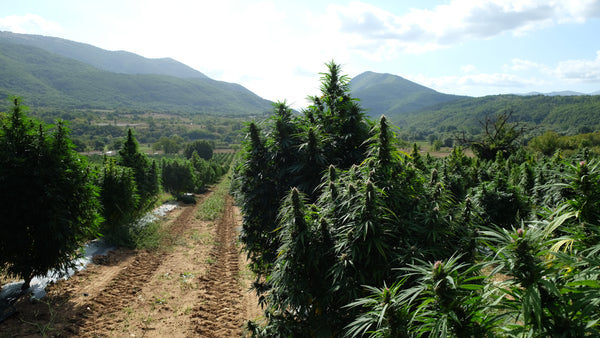To ensure you harvest marijuana in abundance you need to carefully follow the flowering process, week by week. Making mistakes during this phase means in most cases compromising the harvest in terms of quantity and quantity.
This also applies to indoor cultivations, given that outdoor growers, during flowering, will still have to indulge and support the natural growth process of the plants. In this article we will delve into the flowering theme in detail, here is what we will see:
- Indoor/outdoor difference in flowering
- Outdoor flowering
- Managing flowering indoors
- The problems of flowering
- Sampling the cannabinoids to understand the % of active ingredient
Indoor/outdoor difference in flowering
The first growth phase of cannabis plants is, as with all other plants, the vegetative growth phase. This is a very important phase, which precedes flowering. The plant develops its root system , grows in height, puts out its branches, roots and leaves and strengthens itself in view of the flowers that will begin to develop in the next phase.
At a certain point you will see the first pistils appear, which are like small white filaments.
It means that the vegetative phase is over and the plant is ready to move towards the flowering phase. This time in nature, as outdoor growers will know well, coincides with the end of summer and the beginning of autumn.
Period of the year in which the days become shorter and exposure to the sun decreases, while the hours of darkness gradually increase until a balanced light cycle of 12 hours of light and 12 hours of darkness is achieved.
Here is the first and perhaps only difference between the two types of flowering. In indoor cultivation, which uses artificial lighting systems for plant growth, the photoperiod is obviously reproduced artificially and this means two things:
- flowering must be induced
- the natural growth cycle of plants can be altered
Flowering in indoor cultivation must therefore be controlled and brings with it the possibility of modifying the natural growth cycle of the plants.
There are conflicting thoughts about this, there are those who usually do it to speed up the harvest, making the most of the potential of this type of cultivation, while those who think that it is harmful to the growth of plants.
During flowering, in both types of cultivation , the plants must be monitored week by week. In both cases, during the first two weeks of flowering you will need to pay attention to two things:
- Do not change fertilizer immediately but continue with the one used during vegetative growth. In fact, in these first fifteen days the marijuana plant will continue to grow , in some cases it could even double. Continue to help her and don't worry: it just means that she is becoming strong for the flowers that will begin to develop shortly thereafter.
- Unless it is a conscious choice and if we have not used feminized seeds, the female plants must be isolated so as to eliminate hermaphroditism, which could generate the annoying presence of too many seeds in the buds.
We recognize male plants because they develop rounded sacs, rather than pistils. Without exceeding, from the second week we can start using the fertilizer for flowering, continuing to monitor the plants week by week, avoiding subjecting them to any type of stress.

Outdoor flowering
Outdoor growers have nature on their side . From the point of view of the light cycle, they don't have to worry about anything other than sowing at the right time and in case of excessively high temperatures covering the plants with photo-resistant sheets.
Knowing that the vegetative growth phase of cannabis plants lasts around sixty days , outdoor growers will sow their cannabis or why not legal cannabis around May in order to ensure the start of flowering at the end of August.
At the sight of the first pistils, outdoor growers will begin to gradually change fertilizer, introducing phosphorus and potassium and gradually reducing nitrogen until it is completely eliminated.
Furthermore, during flowering and especially in the first four weeks when the buds are appearing and starting to develop, outdoor growers will have to make sure that the plant does not suffer excessive stress , for example very strong storms or attacks by insects and parasites .
To have more harvests in less mild areas, outdoor growers could decide to induce flowering in due time by increasing the hours of darkness with the use of a special covering sheet.
Managing flowering indoors
Indoor flowering is induced when the light cycle is artificially altered and goes from 18 hours of light and 6 hours of darkness to 12 hours of light and 12 hours of darkness.
This operation must take place at the right time, trying to respect as much as possible the vegetative growth times of our cannabis variety, which, being indoor cultivation, we will have chosen taking into account the spaces and means at our disposal.
It would be a good idea to change the light cycle starting from the appearance of the first pistils.
It is important to continue to support plant growth with the right fertilizer, without rushing to switch to flowering fertilizer, for at least two weeks.
During flowering the plant needs phosphorus and potassium , which we can introduce gradually from the second week onwards. Remember not to use too much fertilizer or water.
From this moment on, an adequate ventilation system is essential to avoid humidity . After the first two weeks the cannabis plants will begin to develop the first buds . We will gradually decrease nitrogen to increase phosphorus and potassium, nutrients that plants need a lot at this time.
We continue to monitor our plant week by week throughout flowering, taking care to eliminate any excess marijuana leaves , compromised branches or leaves, anything that could remove nutrients, which must now be concentrated on the buds that are forming. .

The problems of flowering
The main enemies of flowering are:
- Molds are the biggest threat to our plants. Let's make sure there is no water stagnation , always check the temperature and ventilation . Keep the plant clean and remove any yellowed or damaged marijuana leaves. We only use clean tools and scissors to treat our plants. And…we practice apical pruning beforehand.
- Poor drainage : Well-drained soil is lucky soil, this applies to all plants, including the marijuana plant. Good drainage of the soil, achieved for example with expanded clay , will prevent rotting of the roots and help the plant breathe better.
- Excess water : you will need to increase the water week by week, but start with very modest quantities especially in the first two weeks
- Excess fertilizer : if we fertilize too much they will not grow any more , they will simply burn. We gradually eliminate nitrogen starting from the third week of flowering.
- Lack of nutrients : let's not forget to introduce phosphorus and potassium gradually from the first two weeks.
- Wrong light (indoor cultivation): during vegetative growth we will prefer cold light , while during flowering it will be better to use warm, golden light
- Dark not dark : Is the dark phase of the light cycle disturbed by a light source? Better to take action because the plant is sensitive to these alterations and loves complete darkness .
- Calcium deficiency : about halfway through flowering it is a good idea to begin gradually introducing a little calcium , which helps keep the plant healthy in this phase of effort
- Temperatures too low or too high : the ideal is for cannabis plants to be at a temperature ranging from 24 to 30 degrees. Lower or higher temperatures can in most cases slow down plant growth and in some cases stop it completely.
Sampling the cannabinoids to understand the % of active ingredient
Through screening and analysis processes, it is possible to identify cannabinoids and quantify their percentage content .
This allows us to supply high quality, even therapeutic products with certified safety, for example with a high CBD and CBG content, on which important medical and pharmacological discoveries have been and continue to be made .
Sampling techniques are also used to ensure that the percentage of THC contained in legitimate cannabis is actually 0.2% , therefore within the limits permitted by law.
Finally, it is the method used to establish the quantity of THC contained in cannabis plants in the case of non-legal cultivation. In any case, it is important to know that any sampling must be done not during flowering but after flowering has occurred .
During flowering, the marijuana plant has not yet developed the maximum percentage of active ingredient therefore sampling could be distorted.
Our legal cannabis is grown organically and certified , has a very high CBD content and a THC content that falls perfectly within the canons of current law.
If you are thinking of buying marijuana online, we invite you to take a look at our site, where you can find quality seeds and inflorescences.
If the article was of interest to you, share it on social media with the rest of the Community, every single share helps us support our blog and keep you 360° informed on the world of Cannabis.
You might also be interested in:








